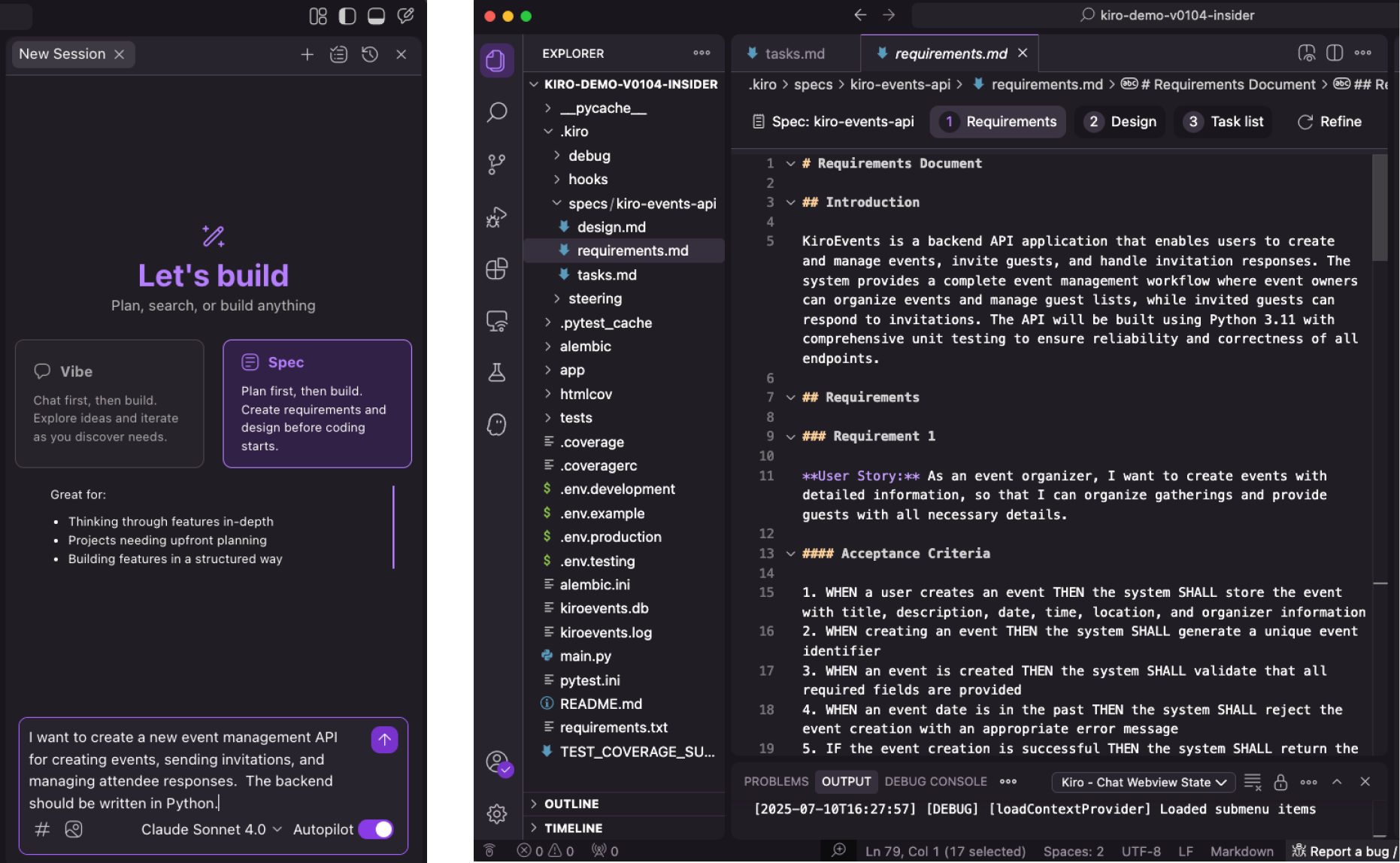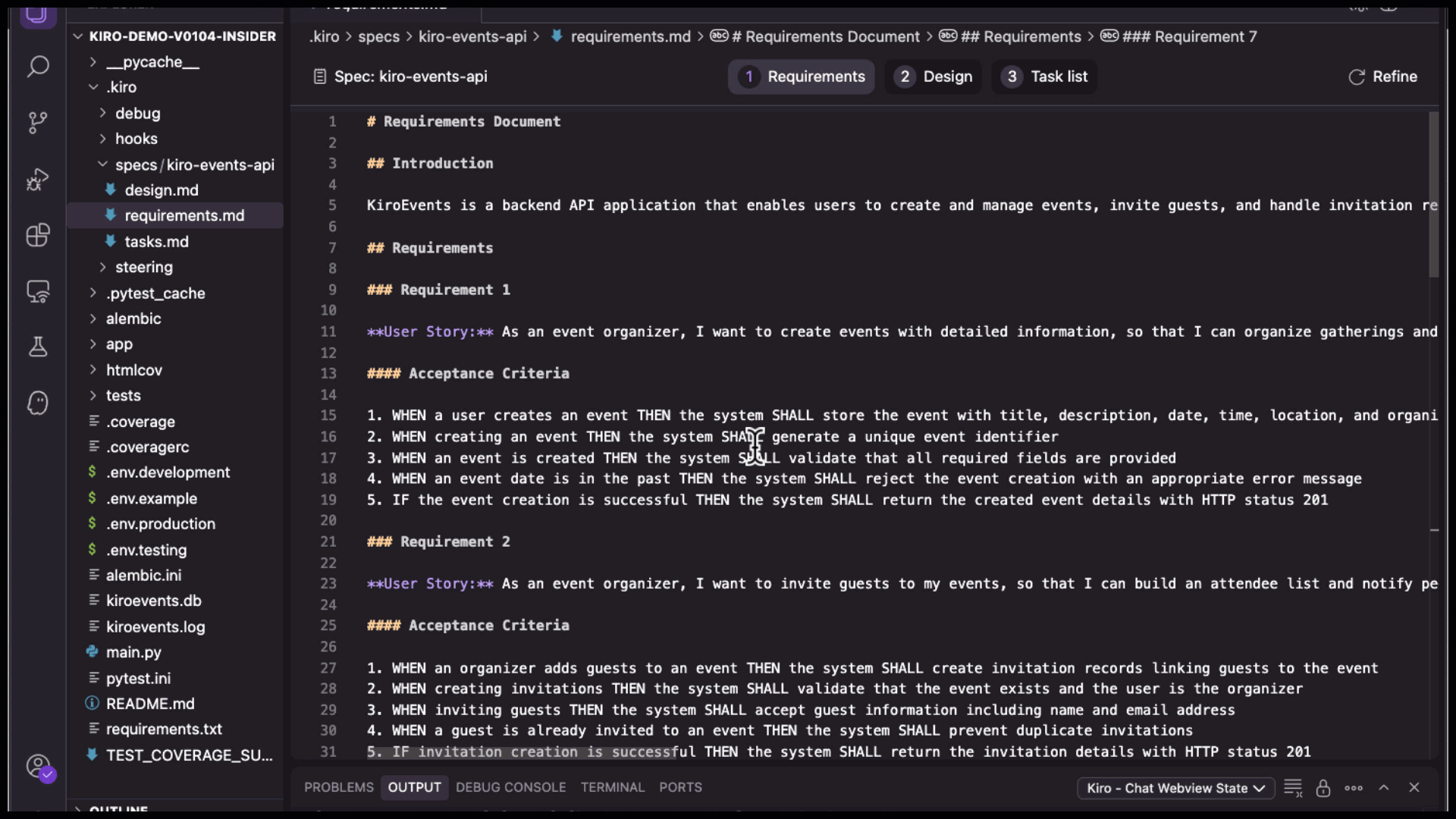From chat to specs: a deep dive into AI-assisted development with Kiro
Ryan Yanchuleff
Developer
As developers, we've all been there. You have a brilliant idea for a feature or application, you fire up your favorite AI coding assistant, and then... you spend the next hour going back and forth, refining requirements, clarifying edge cases, and watching your context window fill up with exploratory conversations before you even write a single line of code.
Kiro, a new IDE, fundamentally changes how we approach AI-assisted development through Spec-Driven Development.
Limitations of current AI coding assistants
Limitations of current AI coding assistants tend to follow a predictable and inefficient pattern. When a developer provides a high-level prompt, the AI immediately jumps into code generation, often before fully understanding the requirements. This premature action leads to a cycle where the developer must repeatedly clarify their intentions with "actually, I meant..." statements, as the initial requirements weren't sufficiently clear. As this exploratory dialogue continues, the context window becomes increasingly cluttered with back-and-forth discussions, leaving limited space for the final code generation. This constrained context space ultimately impacts the quality and completeness of the final output, making the entire process less efficient than it could be. This approach treats the LLM as a code generator first, when it should be considered a thinking partner throughout the entire development lifecycle.
Spec-driven development: Bridging design intent and implementation
If you're working on a challenging feature, Kiro serves as your intelligent sounding board to help you understand your codebase, define your problem clearly, and reach a quality solution efficiently. You can collaborate with Kiro on creating concise specifications that include clear requirements, system architecture, tech stack considerations, and implementation approach. Kiro helps make all requirements and constraints explicit, then uses these specifications as context to complete tasks with fewer iterations and higher accuracy. This is the power of spec-driven development. Let's dive deeper into some of the key benefits of Kiro's approach:
1. Understand your existing codebase
Before starting new development, Kiro analyzes your existing code and generates three foundational documents: structure.md (codebase architecture), tech.md (technical stack and patterns), and product.md (business context and requirements). This gives you and your team a clear baseline understanding that informs all subsequent specification work. Existing codebases can now take advantage of this new paradigm.
2. Analyze and plan your project
When you provide a project prompt in spec mode, Kiro's AI doesn't immediately start coding. Instead, it performs deep analysis to understand your requirements, identifies potential challenges, and creates comprehensive planning documents.
3. Generate comprehensive planning documentation
From a simple prompt, Kiro creates detailed specification files including:
Requirements Analysis - Breaking down your prompt into specific, actionable requirements
Technical Design - Architecture decisions, technology choices, and implementation approach
Task Breakdown - Granular development tasks with clear acceptance criteria
4. Collaborate with AI effectively
Kiro saves specification files in your project directory as readable markdown files. You can review, edit, and refine them before any code is written. This creates natural checkpoints for collaboration with team members or stakeholders.
5. Maximize coding context and efficiency
When it's finally time to write code, Kiro references these specification files rather than cluttering your context window with exploratory conversation. This means maximum context space is available for the actual coding task.
The power of spec-driven development
Spec-driven development delivers key advantages that fundamentally improve how teams design, build, and maintain software. Rather than treating planning as overhead, it becomes your competitive advantage. Here's how this approach transforms the development process:
Catch problems before they're expensive
Rather than discovering requirements issues mid-development, Kiro identifies and resolves ambiguities upfront. This prevents costly rewrites and provides alignment before coding begins.
Stay in control of your project's direction
The specification phase creates natural pause points where humans can review, modify, and approve the direction before resources are invested in implementation.
Iterate without losing your progress
If you make a mistake in defining your requirements, no problem. You can modify the specification files and regenerate the implementation plan without losing your entire conversation history.
Keep your AI focused on what matters
By externalizing the planning phase to files, Kiro keeps the active context focused on the immediate coding task, leading to higher quality code generation.
Enable seamless team collaboration
Specification files serve as living documentation that team members can review, comment on, and contribute to using standard development workflows.
Build institutional knowledge
Every decision and requirement is documented, creating a clear audit trail of why certain technical choices were made and preserving context for future team members.
Let’s see Kiro specs in action
The best way to understand spec-driven development is to see it in practice. Whether you're starting fresh or working with an existing codebase, Kiro's systematic approach enables you to build on a solid foundation. Here's how a typical workflow unfolds, from initial concept to implementation-ready specifications.

Step 1: Initiating your project
Before diving into new features, establish context for your project:
User: "Set up steering for this project"
Kiro analyzes your existing codebase and generates three foundational documents:
structure.md - Current architecture, key components, and code organization
tech.md - Technology stack, patterns, and technical constraints
product.md - Business context, existing features, and user workflows
This gives you a clear baseline understanding of what you're building upon.
Step 2: Generating your project specs
Now start laying out the details for the project that you want to build.
User: "I want to build a task management app for small teams with real-time collaboration features"
This is where the magic of spec-driven development becomes apparent. Rather than jumping straight into framework selection or database design, Kiro takes a step back to fully understand what you're trying to accomplish. It considers your prompt in the context of the steering documents, identifying how this new feature fits within your existing architecture and constraints.
Kiro creates a series of documents in sequential order, building from requirements through to actionable tasks:
requirements.md - Detailed feature breakdown including user stories and acceptance criteria
design.md - Architecture and technology decisions including frameworks, architecture diagrams, and structure
tasks.md - Development phases and tasks to be executed in a sequential order

Step 3: Reviewing and refining
You review the specifications, perhaps adding:
Step 4: Informed Development
Now when Kiro begins coding, it references these comprehensive specifications rather than trying to infer requirements from conversation history. Every implementation decision is grounded in documented requirements and design choices.
The future of development is here—and it starts in the specs
Spec-driven development represents a shift from reactive coding to proactive specification that isn't just a workflow improvement—it's a fundamental evolution in how we partner with AI to build software. Instead of treating AI as a sophisticated autocomplete tool, spec-driven development positions it as your strategic thinking partner, helping you make better decisions before they become expensive to change. The result? Faster development cycles, higher quality code, fewer surprises, and documentation that actually stays current because it's integral to the process, not an afterthought. The next time you have a feature to build, try leading with specification instead of code. Your future self (and your teammates) will thank you for the clarity, and you might just discover that the best code is the code you plan before you write.
Ready to experience the difference? Join the waitlist.